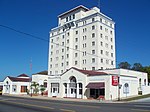Florida participated in the American Civil War as a member of the Confederate States of America. It had been admitted to the United States as a slave state in 1845. In January 1861, Florida became the third Southern state to secede from the Union after the November 1860 presidential election victory of Abraham Lincoln. It was one of the initial seven slave states which formed the Confederacy on February 8, 1861, in advance of the American Civil War.
Florida had by far the smallest population of the Confederate states with about 140,000 residents, nearly half of them enslaved people. As such, Florida sent around 15,000 troops to the Confederate army, the vast majority of which were deployed elsewhere during the war. The state's chief importance was as a source of cattle and other food supplies for the Confederacy, and as an entry and exit location for blockade-runners who used its many bays and small inlets to evade the Union Navy.
At the outbreak of war, the Confederate government seized many United States facilities in the state, though the Union retained control of Key West, Fort Jefferson, and Fort Pickens for the duration of the conflict. The Confederate strategy was to defend the vital farms in the interior of Florida at the expense of coastal areas. As the war progressed and southern resources dwindled, forts and towns along the coast were increasingly left undefended, allowing Union forces to occupy them with little or no resistance. Fighting in Florida was largely limited to small skirmishes with the exception of the Battle of Olustee, fought near Lake City in February 1864, when a Confederate army of over 5,000 repelled a Union attempt to disrupt Florida's food-producing region. Wartime conditions made it easier for enslaved people to escape, and many became useful informants to Union commanders. Deserters from both sides took refuge in the Florida wilderness, often attacking Confederate units and looting farms.
The war ended in April 1865. By the following month, United States control of Florida had been re-established, slavery had been abolished, and Florida's Confederate governor John Milton had committed suicide by gunshot. Florida was formally readmitted to the United States in 1868.










